May 2009
AVS Update (finally)
24 - May - 2009 - 22:00
So, at long last, I am finally updating the blog on the progress of the Armed Virginia Sloop.
I have been make slow but steady progress on the ship over the past two months, and more recently I've tried to increase my pace a little bit, as I was getting discouraged by the lack of visible progress. Currently, I have finished the first layer of exterior planking on the hull and am just beginning the walnut layer on both the inside of the rails and on the outside. Here are some images from the past two months and a little bit about them:

This first one shows the installation of the waterways, which I had been hung up on for a while. These were fairly thick, laser-cut, walnut parts that required a pretty big bevel along their length. Since I thought this was going to be tricky to get right, I had stalled for a while on it (plus I was pretty busy in outside life as well). But, once I got down to it, it turned out to not be that big a deal and I only cut myself a few times with the x-acto knife ;)

This next image shows the rear cabiny thing pretty much all done. This was actually a multi-step process, consisting of first planking in basswood. This first step was my introduction to planking with soaked wood (for added flexibility), which turned out to be quite handy. Once the area was planked with the basswood, it got a good sanding, and then the window frames were installed. I had some left over window plastic from the last boat I built (the Chris Craft at the bottom), so I cut some small squares from that and glued those to the backs of all the window frames with some Testors clear parts cement. Next, the area was given a final planking with the walnut layer, which required some delicate cutting and fitting around the frame areas. To finish it off, the surface was sanded smooth and given a light coat of polyurethane to seal it up a bit.

Here is another view of the cabin area. You can also see the first few planks going on the side. This mostly involved a process of roughly measuring the planks, then soaking them in water for a bit, then attaching them with super glue. Once the wood had dried out a bit, things are trimmed and sanded to fit nicely.
There is a bit of a trick to this whole stern area, as many of the bits sort of rely on one another for positioning. The course that I am following (see link in sidebar) does a good job of differing from the kits instructions in order to make these interrelationships obvious. As a result, it sort of skips back and forth for a bit, adding a few planks, then some trim pieces, then more planks, etc.
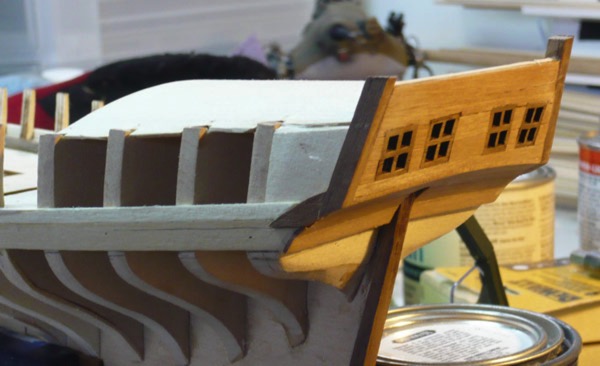
Here is an image of the walnut trim corner pieces in place. These interact with the installed walnut planking, as well as the side planks in the way that it fits together. This step also required a bit of muscle (delicately) to bend my top rear planks out a bit. They had ended up curling in a bit, so that when i installed the straight trim pieces, they did not line up properly. With a little bit of super glue, some delicate but firm pressure, and some patience, I managed to bend the rear surface out a bit to align with the trim. This looked much better and generally filled life with happiness ;)
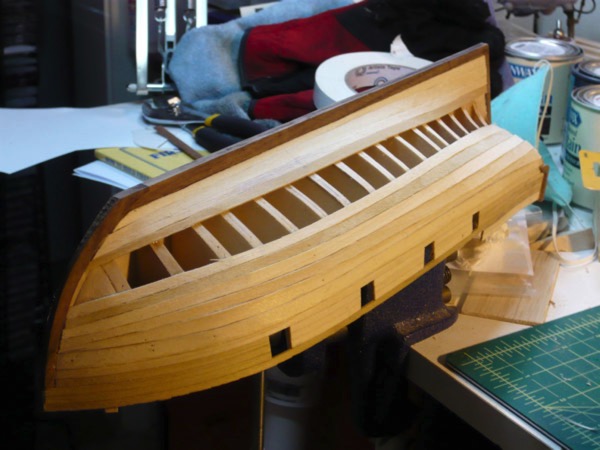
Skipping ahead a few weeks, the planking is well underway. This mostly involved steps of pinning, drawing guide lines along the planks, unpinning, careful cutting, soaking and then finally gluing in place, with a bit of trimming at one end for a proper fit. Not too tough, really, but pretty slow going. I think I averaged two to four planks on evenings that I was able to work on the ship. The image to the left is probably three to four weeks of slow work. Once I got this far though, I got excited about being almost done this stage, and pushed ahead a bit quicker. As a result, I am now all done with the basswood planking!
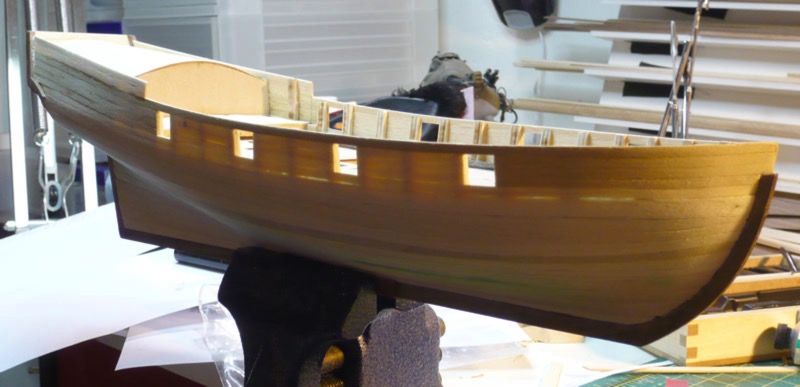
As you can see, in this image, The planking is complete and I've spent a bit of time sanding the whole hull and filling in a few gaps with green putty. Overall, I'm quite pleased with how it turned out
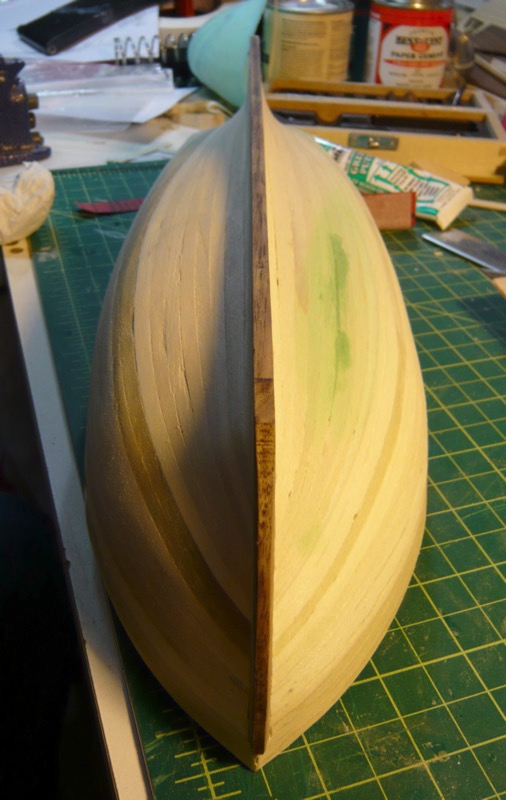
for being my first ship. There are a few areas that could be better (hence the need for the filler), but really nothing that is too bad. It was a bit tricky getting the planks to bend at the stern, as the planks were pretty wide (1/4") and the required bend was pretty extreme. But once all was sanded and filled, it seemed to work out just fine.
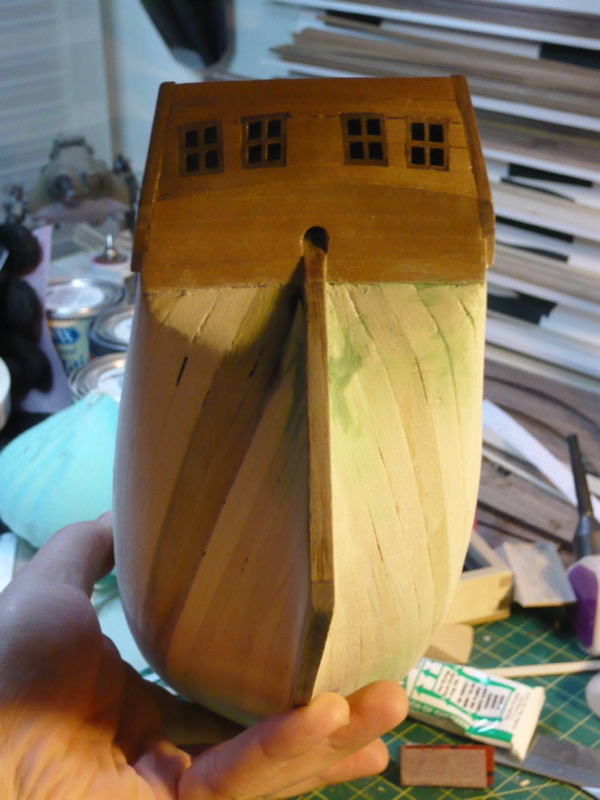
Next up is to begin the walnut planking on the interior of the railing. I believe this also involves a bit of cutting and fitting to a few pieces, but didn't look too complicated.
I'm hoping to be a little better about updates from here on, so keep an eye out for small posts as I progress!
Also, on a side note, be sure to go see Pixar's 'Up' this coming week, when it comes out! It's a great film!
I have been make slow but steady progress on the ship over the past two months, and more recently I've tried to increase my pace a little bit, as I was getting discouraged by the lack of visible progress. Currently, I have finished the first layer of exterior planking on the hull and am just beginning the walnut layer on both the inside of the rails and on the outside. Here are some images from the past two months and a little bit about them:

This first one shows the installation of the waterways, which I had been hung up on for a while. These were fairly thick, laser-cut, walnut parts that required a pretty big bevel along their length. Since I thought this was going to be tricky to get right, I had stalled for a while on it (plus I was pretty busy in outside life as well). But, once I got down to it, it turned out to not be that big a deal and I only cut myself a few times with the x-acto knife ;)

This next image shows the rear cabiny thing pretty much all done. This was actually a multi-step process, consisting of first planking in basswood. This first step was my introduction to planking with soaked wood (for added flexibility), which turned out to be quite handy. Once the area was planked with the basswood, it got a good sanding, and then the window frames were installed. I had some left over window plastic from the last boat I built (the Chris Craft at the bottom), so I cut some small squares from that and glued those to the backs of all the window frames with some Testors clear parts cement. Next, the area was given a final planking with the walnut layer, which required some delicate cutting and fitting around the frame areas. To finish it off, the surface was sanded smooth and given a light coat of polyurethane to seal it up a bit.

Here is another view of the cabin area. You can also see the first few planks going on the side. This mostly involved a process of roughly measuring the planks, then soaking them in water for a bit, then attaching them with super glue. Once the wood had dried out a bit, things are trimmed and sanded to fit nicely.
There is a bit of a trick to this whole stern area, as many of the bits sort of rely on one another for positioning. The course that I am following (see link in sidebar) does a good job of differing from the kits instructions in order to make these interrelationships obvious. As a result, it sort of skips back and forth for a bit, adding a few planks, then some trim pieces, then more planks, etc.

Here is an image of the walnut trim corner pieces in place. These interact with the installed walnut planking, as well as the side planks in the way that it fits together. This step also required a bit of muscle (delicately) to bend my top rear planks out a bit. They had ended up curling in a bit, so that when i installed the straight trim pieces, they did not line up properly. With a little bit of super glue, some delicate but firm pressure, and some patience, I managed to bend the rear surface out a bit to align with the trim. This looked much better and generally filled life with happiness ;)

Skipping ahead a few weeks, the planking is well underway. This mostly involved steps of pinning, drawing guide lines along the planks, unpinning, careful cutting, soaking and then finally gluing in place, with a bit of trimming at one end for a proper fit. Not too tough, really, but pretty slow going. I think I averaged two to four planks on evenings that I was able to work on the ship. The image to the left is probably three to four weeks of slow work. Once I got this far though, I got excited about being almost done this stage, and pushed ahead a bit quicker. As a result, I am now all done with the basswood planking!

As you can see, in this image, The planking is complete and I've spent a bit of time sanding the whole hull and filling in a few gaps with green putty. Overall, I'm quite pleased with how it turned out

for being my first ship. There are a few areas that could be better (hence the need for the filler), but really nothing that is too bad. It was a bit tricky getting the planks to bend at the stern, as the planks were pretty wide (1/4") and the required bend was pretty extreme. But once all was sanded and filled, it seemed to work out just fine.

Next up is to begin the walnut planking on the interior of the railing. I believe this also involves a bit of cutting and fitting to a few pieces, but didn't look too complicated.
I'm hoping to be a little better about updates from here on, so keep an eye out for small posts as I progress!
Also, on a side note, be sure to go see Pixar's 'Up' this coming week, when it comes out! It's a great film!
